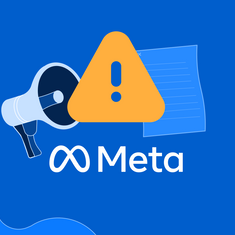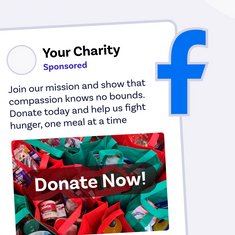
If you've never advertised on social media or you're not seeing results, follow these tips for your nonprofit advertising.
If you want to drive some serious traffic to your donation page or peer-to-peer campaign you are probably running Facebook ads.
With recent changes to Meta’s Ads platform, ad creation has become more streamlined and things like managing placements or micro-targeting your audience have become less important (and effective).
BUT there is still one element of your ads that you are in control of and can make a huge difference to the success of your campaign: your creative.
I review a lot of ad accounts and I find myself making the same recommendations over and over again. So here they are…
7 simple things you can do to improve your Facebook ads creative:
1. Talk to your audience like you would talk to a friend.
The right tone of voice may vary depending on your audience but generally speaking, the less formal, the better. Audiences on Facebook HATE to think they are responding to ads, so the more you can make your post look like a spontaneous post, the better.
This means:
- Using plain, informal language that everyone understands.
- Refer to yourself as ‘we’ and your audience as ‘you’
- Avoid jargon or uncommon acronyms, including terms common in the nonprofit sector like empower and lived experience.
- Avoid waffle. If you can say it in 3 words don’t use 7.
2.Make sure your ads have a clear call-to-action.
Don’t assume people will know what you want them to do. Tell them!
Be sure to include an explicit ask like ‘Donate now’ or ‘Sign up today’ in your ad's Primary text or Heading.
Only include one ask in an ad BUT don’t be afraid to experiment with including that ask multiple times within your ad.
3.Test longer Primary text options.
While Facebook recommends your Primary text be no more than 125 characters, I’ve seen longer ads outperform one-liners over and over again.
How long are we talking? This experiment by adespresso tested 6 different options and found that 1, 3 or 6 paragraphs all performed better than shorter options.
Longer Primary text options give you more room to tell a story and outline the problem and your solution. Just be sure to include a strong hook upfront. As a bonus, when people click to expand the text this will show Facebook that people are engaging with your ad - giving your ads some algorithmic juice!
4.Make your copy as readable as possible.
This means:
- Use short sentences and plenty of line breaks.
- Try not to use capital letters unless you really need to (such as for proper nouns or the start of a sentence). Job titles don’t need capital letters and you can usually shorten organisation names to generic terms.
- Don’t use hashtags within text; pop them at the end if you feel like you need to use them.
Can you see how much easier it is to read the first ad compared to the second?
A bonus accessibility tip: Always use camel case for hashtags. #ThisIsCamelCase #thisisnotcamelcase. This way, screen readers can distinguish individual words and people who rely on them will be able to understand your hashtags.
5. Find your Power Words.
There are some words that are just supercharged with emotion and when people read them they are compelled to engage with your ads.
Some of my favourites are ‘help’, ‘urgent’, ‘breaking’ and ‘best’. I always see a boost in click-through rates when I include these words but there are plenty of options.
6. Add some text to your images.
Every time I test an image with text on it against the same image without text, the image with text performs better.
You could try including the call-to-action or a testimonial or quote on your image.
If you don’t have the budget or in-house team to have it professionally designed, something you can pull together with a Canva template will usually do the trick. (Did you know Canva offers free premium subscriptions for nonprofits).
7. Finally, read your copy out loud.
Before you hit publish on your ads, read your ad copy aloud.
Ask yourself if it sounds like something you would say in conversation. If it sounds like jargon or marketing speak, it is probably not going to fly.
Creating great ads takes time and effort, but I hope these 7 simple tips will help you to get started with creating ads that are engaging and effective.
Don’t forget to test and track your results. One of my favourite things about Raisely is how easy it is to set up the Facebook pixel and track your donations and P2P campaign sign-ups. Don’t miss this step.
Stay in the loop. Delivered to your inbox twice a month.

Founder and lead consultant at Karma Campaigns. Jo is passionate about helping nonprofits meaningfully connect with their supporters through killer content.




